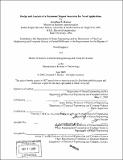Design and analysis of a permanent magnet generator for naval applications
Author(s)
Rucker, Jonathan E. (Jonathan Estill)
DownloadFull printable version (22.83Mb)
Other Contributors
Massachusetts Institute of Technology. Dept. of Electrical Engineering and Computer Science.
Advisor
James Kirtley.
Terms of use
Metadata
Show full item recordAbstract
This paper discusses the electrical and magnetic design and analysis of a permanent magnet generation module for naval applications. Numerous design issues are addressed and several issues are raised about the potential improvements a PM generation system can offer. A proposed 16 MW PM generation module design is presented along with a detailed design methodology. Eighty different machines and power conversion modules are sized, designed, and analyzed with a final design selected. Specifically, sizing and detailed machine design and analysis is performed examining the effects of numerous parameters including number of phases, number of poles, magnetic geometry, machine dimensions, and material types. Analytical models are developed to study rotor losses caused by stator winding time and space harmonics and slot space harmonics. Power electronics and conversion modules to connect the high-speed generator to a DC distribution system are designed and analyzed. In depth simulation of the eighty complete systems is performed using the software programs MATLAB (Version 12.0, Mathworks) and PSIM (Version 6.0, Powersim, Inc.). The 16 MW permanent magnet generation module, consisting of the generator and associated power electronics, provides an excellent alternative to traditional wound rotor synchronous machines. The final design offers significant reductions in both weight and volume. Specifically, it is estimated that the PM generation module has a 7x reduction in volume and a 10x reduction in weight compared to similarly rated wound rotor systems. These reductions can provide flexibility to naval architects since power, weight, and volume are integral parts of the design and construction processes. However, further study is necessary to verify the PM generation modules thermal, structural, and mechanical performance.
Description
Thesis (Nav. E.)--Massachusetts Institute of Technology, Dept. of Ocean Engineering; and, (S.M.)--Massachusetts Institute of Technology, Dept. of Electrical Engineering and Computer Science, 2005. Includes bibliographical references (p. 129-133).
Date issued
2005Department
Massachusetts Institute of Technology. Department of Electrical Engineering and Computer Science; Massachusetts Institute of Technology. Department of Ocean EngineeringPublisher
Massachusetts Institute of Technology
Keywords
Ocean Engineering., Electrical Engineering and Computer Science.